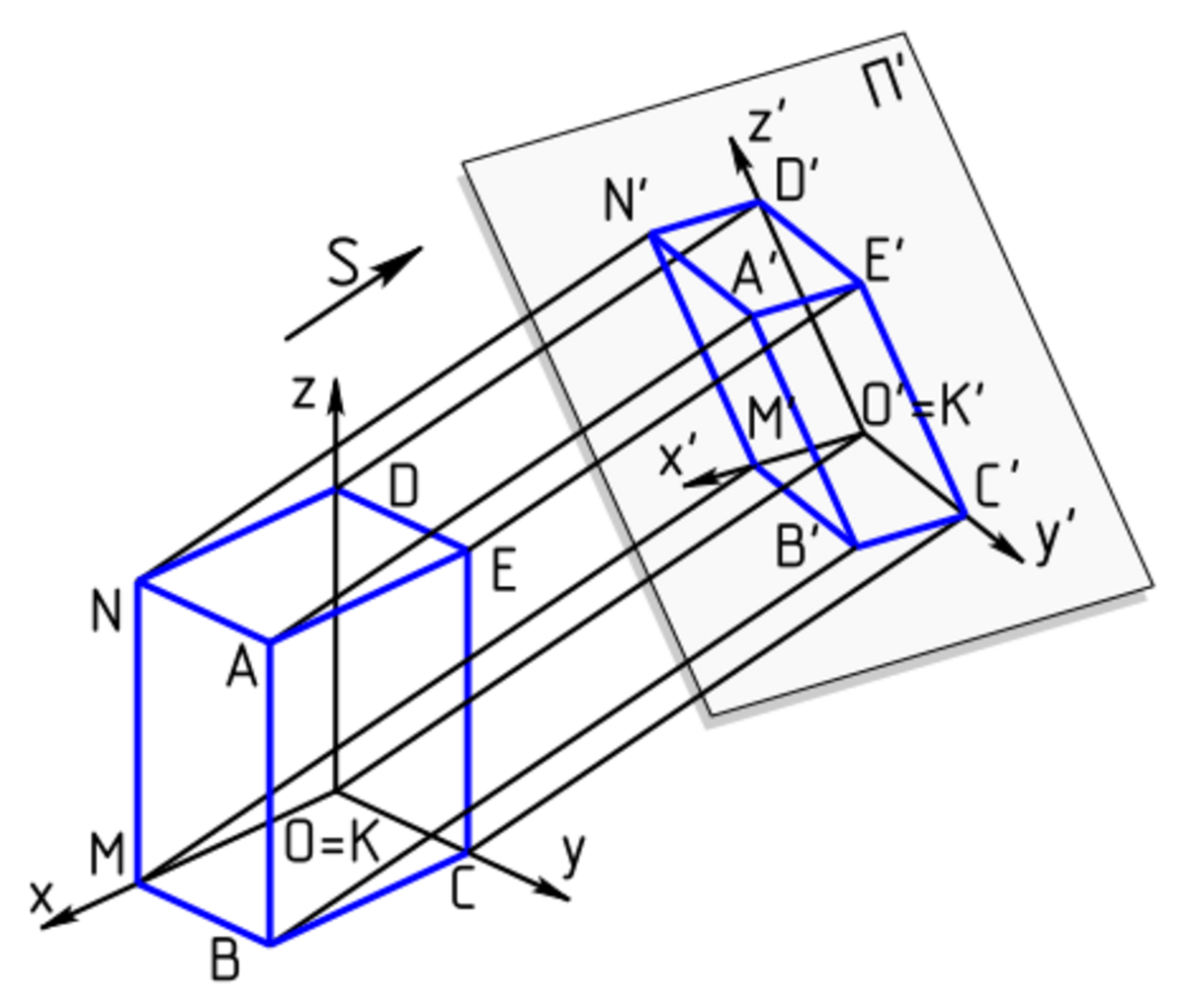How Does Cabinet Projection Appear Realistic?
In cabinet projection one face of the object is parallel to the viewing plane, and the third axis goes off in an angle (typically 30 degree or 45 degrees). The receding lines are shortened by half their true length.
Unlike cavalier projections, the receding axis in cabinet oblique drawings is shortened by half to compensate for distortion and to approximate more closely what the human eye would see. This makes the drawing appear more realistic and believable. In this article, we will discuss about Cabinet Projection Appear Realistic Compared To Cavalier Projections.
Also Read: An Example Of An Individual Financial Coi Is
Oblique Projection
Oblique projection is a technique used for drawing graphical representations of three-dimensional objects on two-dimensional planes. It is the most common method for technical drawing and is used by architects to show the appearance of a building or by artist-draft men to prepare illustrations of huge machinery or equipment.
In oblique projection, lines that are perpendicular to the drawing plane are preserved and the lengths of lines that are parallel to the drawing plane are reduced. This reduces the dimensionality of the drawing and gives an illusion of depth to the image.
The resulting visual effects can be visually pleasing and useful for certain applications, but they also produce distortions that are difficult to remove and are less accurate than traditional methods. In particular, the oblique technique can be applied to remove multi-scattering effects in close-range hyperspectral images (Al Makdessi et al., 2019).
There are two main types of oblique projections: Cavalier and Cabinet. Both preserve the lengths of lines that are perpendicular to the projection plane, but they differ in how much they are reduced and which axes are drawn with a varying scale.
Cavalier projections have a tendency to look odd and distorted to the eye, especially when drawing curved features, and so are often avoided by professional designers and engineers. However, they are often still used in industrial drawings.
Cabinet projections are less prone to the optical effects of cavalier projections and appear more realistic, since they only reduce lines that are perpendicular to the image. They are also easier to draw than cavalier projections, but it is essential that the correct measurements are made in order to construct a good oblique projection.
When using oblique projections, you should always draw the front or side view of the object first to ensure that all the measurements are correct. Then, all the other measurements are drawn backwards half of the original measurement, creating a ‘forced depth’ effect that adds to the realism of the image.
Oblique projection can be easily adapted to various different scenarios and can help with many aspects of a design or engineering project. It is also a relatively simple technique, and it is easy to learn. In addition, it can be very helpful in spectral corrections, where it can be used to remove multi-scattering effects from close-range hyperspectral images of vegetation scenes.
Cavalier Projection
Cavalier projection (also called cavalier perspective or high view point) is a type of oblique projection. It preserves the length of lines perpendicular to the projection plane but enables distortions. This makes the object appear more realistic than cabinet projection.
It is the most commonly used form of oblique projection. It was first used by French military artists in the 18th century to depict fortifications. It is also common in technical drawing and illustrations.
Objects drawn in a cavalier projection appear more realistic than those drawn in cabinet projection because the oblique edges are not distorted as much. In addition, the oblique edges (called receding lines) all point in the same direction towards a vanishing point at an angle between 30 and 45 degrees, creating an optical illusion that makes the objects seem to lean over slightly.
Students can use a Polypad to explore this illusion using objects drawn in cavalier and cabinet projections. They can then compare the differences between the two.
In this activity, they will draw a rectangular prism in a cavalier perspective and compare the drawing to reality. They will also see how oblique edges can be represented by dotted lines in the image.
This activity can be done in pairs or in the form of a whole class discussion. After the students have completed the project, you can have them complete the rest of the activities in this lesson.
Alternatively, you can provide students with a list of three-dimensional objects and ask them to select one object from the list. They can then try to find the object in cavalier, cabinet, and general projections.
They will then have to make the object stand out in the drawings. They can also use a Polypad to create a similar illusion with another object.
Using this activity, students will learn about oblique projections and be able to explain why they are more realistic than orthographic projections. They will also be able to explain why it is important for artists to choose the right oblique projection for each project. They will also be able to compare the pros and cons of each oblique projection.
Cabinet Projection
Unlike cavalier projections, which use the same length for all receding lines, cabinet projection reduces the length of those receding lines by half. This gives a more realistic representation of an object.
Another reason that oblique projections appear more natural than perspective drawings is that they correct a human optical illusion, which makes distant objects seem smaller than they actually are. This is often referred to as the “fish bowl effect.”
The most obvious way that oblique projections work is to display one face of the object as a one-to-one or scaled copy, and then distort the other faces using different angles. This allows designers to highlight a particular face or feature of the object.
A good way to demonstrate the difference between oblique and parallel projections is to ask students to draw an object using each technique. After drawing the same object, have them compare their drawings to determine which is the most realistic.
When choosing which method to use, consider the type of object you are drawing and the audience you are trying to reach. Cavalier will likely be more useful for objects that need to be drawn from above (such as cities or fortifications) and cabinet will most likely be better suited for things like furniture that are best seen on the ground.
For example, a stairway may be easier to draw and measure in the cavalier method, but cabinet would be better for an illustration of a vertical piece of furniture such as a wardrobe.
As with all oblique projections, there are some pros and cons to each. For instance, cavalier is easier to draw and measure in the x and y axes, but cabinet will give a more natural perception of volume as well as plan.
Both oblique projections are very simple to implement, so they can be used in both technical and informal applications. In some cases, they are the only option when a drawing of an object needs to be quickly and casually made. In other cases, they are the only choice for a high-quality drawing that will be reproduced for many years to come.
Optical Illusion
There are a lot of different types of optical illusions, including:
Distorting Illusions: These illusions make things look longer, shorter, bigger, or smaller than they really are. They may also have asymmetrical shapes. Examples of this include the Ponzo Illusion, where two identical lines appear to be different lengths.
Paradox Illusions: These illusions rely on the brain’s mistake that two edges must always connect. They can be very convincing, but they would be impossible in three dimensions.
These illusions can help you see a lot of details and patterns that you otherwise wouldn’t be able to, and they are great for visual learners.
Optical illusions can be fun and entertaining, but they’re also a great way to test your brain! Research shows that puzzles and other brain-teaser activities can strengthen the connections between nerve cells, and can reduce the risk of dementia and Alzheimer’s disease.
The best thing about optical illusions is that they don’t hurt your eyes! The images are simply a mismatch between what you see and the actual properties of the objects.
In most cases, optical illusions are caused by the overstimulation of your brain’s senses. This can happen when you’re viewing an image that contains too much color, light, movement or dimensions for your eyes to process properly.
It’s also possible to trick your eyes with some of the more complex optical illusions, like those that have a hidden message or reflection. For example, in this image, you’ll see black dots that look like words, but they might just be a mirror image of another word.
These kinds of optical illusions are often used in marketing campaigns, because they can create a sense of mystery and wonder that will draw people in. They can be effective for a variety of different businesses, from billboards and commercials to package design and promotional products.
These kinds of illusions can also be very educational, because they can help you learn about the differences between two-dimensional and three-dimensional drawings. In fact, many artists use optical illusions as part of their art. And they’re becoming more common in everyday life, as technology makes them easier to create and display.







